At the end of the 20th century, humanity had a curious strategy for regarding the techno-spaces unfolding with the advancement of digital technology. The newly arrived non-spaces of the World Wide Web had generated a cultural atmosphere of cognitive dissonance bordering on paranoia, a mindset of deep hysteria that had to be sedated with the creation of a new mythology of space. The technological networks facilitating accelerated access to information across the globe were re-conceptualized under this mythology as architectures of bits and pixels, a virtual space completely distinct from the actual reality composed of atoms and matter that we naturally inhabit. Entrance to cyberspace was analogous to religious transcendence, flesh and bone abandoned as mind and spirit entered an immaterial universe of information.[1]
As we move beyond the threshold of the millennia, this mythology evaporates. The worlds of the actual and the virtual have collapsed inwards. Matter and data now collide in a new hybridized reality system in which the spatial distinctions upheld by the mythology of cyberspace have given in to the realization that both worlds are at all times mutually influencing one another.[2] The fantasy of the Internet existing as a utopian destination free of the prejudices, cruelty, and violence of the real world, has crumbled. Humanity has arrived at the cold awareness that causality is not hindered by the barrier that separates the online and the offline.
In terms of aesthetics, the composite reality that has succeeded the last century’s spatial techno-mythologies has already been partially subsumed into the discourse of postmodernism. To this end, the integration of the actual and the virtual becomes the final measure in the eradication of medium specificity. As the limit between matter and information approaches zero, the image finds itself fully released from the restrictive equivocation of medium and message described by Marshall McLuhan in a bygone era of media culture.[3] Postmodern new media artists thus celebrate hybridized reality as a fluid structure that allows aesthetic content to proliferate across a spectrum of material and immaterial forms, continuing the epistemological erosion that Jean-François Lyotard described as the postmodern condition itself.[4]
Despite this enterprise of aesthetics built around the emergence of hybridized reality, this new understanding of space still has the capacity to be understood and theoretically tooled in the epoch of metamodernism. For on the one hand our new hybridized reality is the end result of a postmodern critical process, the demystification of a cultural narrative of transcendence. In this sense, hybridized reality manifests itself after the myth of cyberspace is rationalized onto a terrestrial level of analysis. It is here that the quasi-spiritual mythos of cyberspace is dissected into the science of semiology. But this terrestrialization and subsequent deconstruction also has a modernist dimension to it. As we realize that there is no utopia on the other side of the technological rainbow, we might also come to terms with the fact that awareness of our conduct and activity in all realities determines the optimism nascent in narratives for the future.
Hybridized reality also offers a specific opportunity to further an understanding of new media art in the era of metamodernism. This compounded reality draws two fields of aestheticized spatial engineering closer to one another, making comparisons between the two more tenable and indeed imperative. These fields are the actualized coordination of matter and meaning to create architecture for humans to exist in, and the virtualized manipulation of symbolic substance to create works of contemporary art using the Internet. The shift in reality and our perception of it that creates this opportunity also calls into question fundamental philosophical inquiries. It seems appropriate, then, to utilize the emerging metamodern philosophy of speculative realism to further catalyze our desired comparison. In other words, by using speculative thought to analyze metamodern architecture, we may reveal speculative and thus metamodern tendencies in works of new media art.
Let us begin with a look at the premier metamodern architects Jacques Herzog and Pierre de Meuron. Over the span of their careers, these Swiss designers of space have created a number of structures that accord with the metamodern tenet of oscillation. The designs of their buildings move between poles of natural and urban landscapes, contextual and imaginative composition, and interior shelter and exterior exposure. Of particular interest here is the last of these oscillatory movements in relation to the Herzog & de Meuron designed museum VitraHaus. Completed in 2010, this structure contains the domestically themed design collection of the Swiss furniture company Vitra. Alongside structures by architects including Frank Gehry and Alvaro Siza, VitraHaus stands on the manufacturer’s corporate campus in the German town of Weil am Rhein.
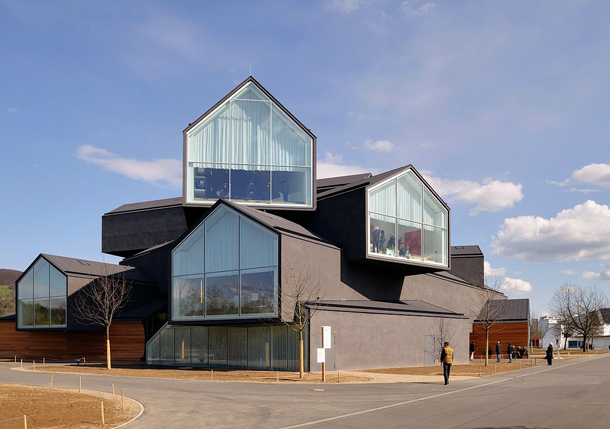
Taking contextual cues from its function as a repository for designed objects relating to the home, VitraHaus is composed of a series of long modular units with ends resembling the basic icon of a house: a triangle atop a quadrilateral. These house-shaped units are then set inside one another at angles and stacked, the facades of components fusing inwards to create the fortified configuration of the museum. Through this treatment of form, the structure retreats into the symbolic and architectural security of the home, a bastion of interiority that protects and shields from the elements. And yet despite this withdraw, VitraHaus’ design undergoes a balanced measure of exteriorization. After being compounded and collided into one another to create a stronghold of interiority, each modular unit of the structure becomes a gaping portal exogenously revealing to the patrons within novel views of the German landscape surrounding Vitra’s corporate estate.
This oscillation between the interior and exterior is not limited to the architectural designs of metamodernism. Osmosis through boundaries of subject (interior) and object (exterior) is also a principle underscoring object-oriented philosophy, a primarily ontological branch of thinking within speculative realism. This ontological paradigm is founded upon the refusal of an anthropocentrism that upholds that objects are only tenable when considered in correspondence to their reconstruction by the faculties of human cognition. Object-oriented philosophy counters this path to solipsism by proposing that the existence of all things can be affirmed through correspondences in which human thinking is not privileged.
The philosopher Graham Harman proposes specifically that objects are rendered in generative relationships to one another on the inside of a third entity, that of intention. To avoid blurring this intentional entity with human agency, Harman elaborates that intentionality need not be cognitive. Rather, it is the form of a sincere preoccupation between the innermost dimension of a real object and the external qualities of another object. As such, intentionality buffers the relationship between things to paradoxically draw them closer together.[5] VitraHaus operates on much the same principle, secluding patrons into the architecture while simultaneously divulging picturesque views of the external landscape.
By pushing the concepts of “home” (interior, subject) and “landscape” (exterior, object) in VitraHaus into familiarity with the subsidiary ontology of speculative realism, we may find likeness between Herzog and de Meuron’s museum and the new media based artwork The Sound of eBay (2008-2009) by the collaborative duo UBERMORGEN.COM. The latter work consists of an algorithmic code written in the programming language SuperCollider that parses the private and public data associated with an eBay user profile and transforms this raw data into a short piece of repetitive electronic music. Visitors to the website that facilitates this generative process enter a profile name and email address and within minutes receive the resultant music via email. Playlists of thousands of these compositions can be accessed online and serve as a form of documentation for the work.
The Sound of eBay conceptually operates in much the same way VitraHaus does, beginning with a site of reinforced interiority that is quickly oscillated with the exterior via aesthetic intervention and design. The initial interior site of UBERMORGEN.COM’s work is an online bazaar that reifies identity as an archive of transactional data: items purchased, sellers interacted with, addresses shipped to and from, methods of purchase, a massive logbook of relevant dates, and so on. The resultant user profiles move between the actual desires of the subject they technologically extend and the virtual fulfillment of these desires; the user profile is indeed a technological expression of interiority in a hybridized reality. These techno-subjects are then mutated with the SuperCollider code in the artwork, exteriorized into a purely aesthetic murmur of electronic music. This is quite similar to Herzog and de Meuron’s fortification of VitraHaus’ modular home units such that the architecture mysteriously opens up to something outside itself.
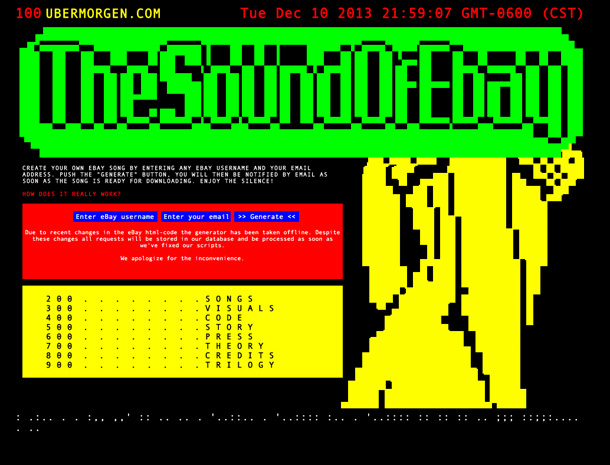
The Sound of eBay also strikes an interesting relationship with the basic project of object-oriented philosophy. UBERMORGEN.COM’s work reads as a reinvigoration of the prophetic texts written by Nick Land that feverishly proposed the significance of digital media to a prototypical vision of speculative realism. Land saw the accelerating digital information systems appearing in the 1990s as apparatuses that would cybernetically emancipate humanity from a phenomenological feedback loop of thinking that reduces reality to “the totality of objects that can be known through experience.”[6] While the myth of cyberspace held that transcendence into the architectures of the digital would dissolve the body while leaving the cognitive capacity of the being intact, Land saw this operation as being more thorough. In radical anticipation of the ontological orientation of speculative realism, Land sees such digital liberation as not merely “a departure from matter in the direction of spirit or the Ideas where the self will find its home” but a complete “dismantling of the self within a machinic matrix.”[7]The Sound of eBay continues on this trajectory of dehumanization by aestheticizing the techno-subject, dissolving the interiority found there into the “emerging planetary technosentience reservoir.”[8]
“self_portrait” from Elliott Mickleburgh by UBERMORGEN.COM
Land’s speculations on ontology are exceedingly brutal and anti-humanist, characteristics that mark it as an obscene realism that is perhaps equally distanced from postmodernism and metamodernism alike. Contemporary speculative philosophy has reassuringly offered us a shimmering hope that emerges after the chaos of the inhuman jungle Land prescribes. We may encounter more of this optimism by looking into Peter Zumthor’s architectural designs for Therme Vals, a hotel and spa located in Switzerland’s Valser valley.
Completed in 1996, Zumthor’s contribution to the Therme Vals complex is a cavernous spa building seamlessly built into the surrounding landscape. The façade of the structure certainly has a metamodern quality to it: slabs of stone fashioned at a quarry in the region are constructed into monolithic rectilinear forms reminiscent of international modernism. The landscape operates as context in this sense, mimicked by the postmodern side of Zumthor’s design sensibility and tooled into the heroic aesthetic of modern architecture.
It is the subterranean galleries of bathhouses within, however, that are of particular interest to this investigation. Walls of stacked stone sheets give a sense of rigidity and consistency to these inner chambers with patterns of horizontal striation marking out the dimensions of the space from corner to corner. A strict obedience to physical forces seems to hold these rooms in place. But such unfaltering solidity is broken up by the literal and metaphorical fluidity of the cleansing spring water about the floors. Faint shimmers of natural light piping in through small openings in the ceiling render the baths in semi-darkness and further lend a secretive aura to Therme Vals’ grottos. An oscillation between the stillness of stones and gravity and the energetic mysteriousness of water and light perfectly suit the space’s function as a place for bathing. After all, such rituals of purification require an ambiance of stasis and repose, something steadfast to assure the bather that the space is afforded a degree of privacy as they disrobe and offer their body to the cleansing waters. But such cleansing is also dynamic; it is a ceremony of rejuvenating one’s vitality, of becoming anew through washing away filth and lifeless skin.
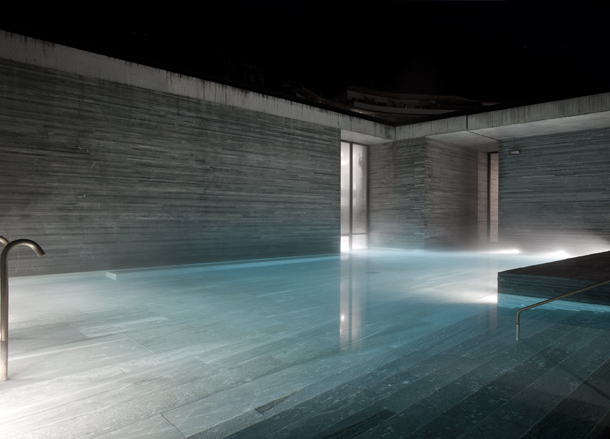
This erosion of persistence in order to facilitate a transformative becoming moves into an architectural vision of the speculative metaphysics proposed by Quentin Meillassoux. Located throughout Meillassoux’s work is a return to the problem posed to philosophy by inductive reasoning, a predicament he devises as the question of whether or not a conclusive argument can be made “for the necessity of observable constants.”[9] Meillassoux’s conclusion holds that such a necessity of persistence exists only in the human subject’s perception of phenomena.
The materials of Zumthor’s bathhouses seem to coincide with this philosophy. The stone of the structure phenomenally provides a necessary grounding in the space for the bathing occupants. Not only is this material corporeal, its use in the architecture is derived from a contextual cue from the surrounding terrain. Through the use of local material and subterranean interface into the Swiss landscape, the bather receives an impression of timelessness, an idea that the vital substance of this building has and always will exist. In contrast, the water, levitating steam, and light in the chambers break from this perceived legality and offer a quality of dynamism to the spas. The occupant’s experience, then, is one that begins with disconnection as the materials of the bathhouses break from necessity and compete with one another. The becoming of bathing is then able to take place.
To elaborate upon this crossfade of architectural and metaphysical concepts, we might turn to the digital work of New York based artist Damon Zucconi as well as the philosophical project of Henri Bergson. Specifically we might review Zucconi’s work Fata Morgana (2010) in relation to Bergson’s renowned concept of intuition, which we might see as another possible outcome of Meillassoux’s regulation of necessity and sufficient reason.
Fata Morgana is remarkably simple: the site for the work consists entirely of a minor aesthetic alteration of the Satellite view in Google maps. The search engine’s exhaustive atlas of the world consists of a scalable 2D image resembling a traditional paper map. Marks for bodies of land and water as well as for routes of transit between points, accompanied with textual annotation for these symbols, adorn the standard Satellite view. Fata Morgana presents this map with only the textual components, erasing everything else and leaving the viewer traveling with clicks and scrolls across a topos of written language. Zucconi’s gesture, then, is one of disconnect, an uncoupling of language that causes the viewer’s experience of the work to recede into an aesthetic intuition of virtual space.
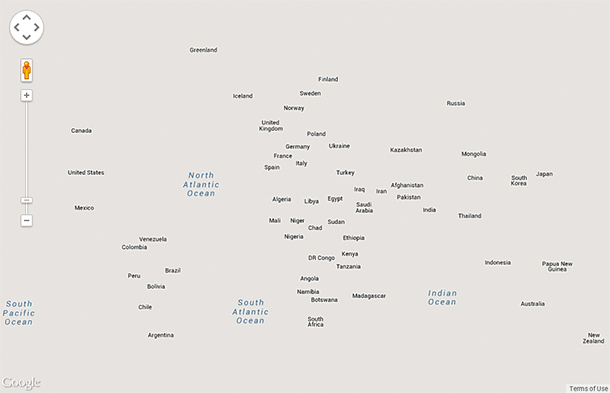
A law is broken in Fata Morgana, much like in Therme Vals. The latter expresses its criminality by breaking from expectation and introducing ephemeral materials into a static stone monument. The former reveals its mischievousness by drifting from the semiological caveat that holds signifiers in connection to some given signified. A postmodern read of Zucconi’s work would end here, leaving us in a pool of deep simulation, a level of representation in which one symbolic system has relieved itself of the requisite reality it once demonstrated. To observe the metamodern quality lurking in this art, however, we must push onwards and discover the result of exploring such a chaotic wasteland of language.
Travel through Zucconi’s purely textual map produces far less anxiety than one might presume. While once familiar symbolic terrains do become almost entirely unrecognizable, the result is an eerily calm fluid space that one glides across somnambulantly. It is as if our intellectual perception of this work has drifted, leaving us with a rather different experience altogether. One withdraws into a landscape that is sensed rather than decoded.
It is indeed this recession into another strategy for encountering the work that is of great importance to our placement of it in relation to speculative philosophy and metamodern architecture. It is already acknowledged that Zucconi’s gesture of erasure creates a rupture in the inductive relationship between signs and their referents. Meillassoux’s philosophical project and Zumthor’s architecture would demonstrate that this breach in necessity opens up routes for unanticipated scenarios to come into being. Zucconi’s artwork twists this substantiation slightly, revealing the presence of aesthetic intuition filtering upwards after the demise of inductive reasoning. For when the “intellectual operation” of reason withdraws, what comes to the forefront of perception is an intuitive grasping of things.[10] The logical demarcations traced unto space and time by the mind fall away, leaving only the infinite smooth space felt by intuition. Subsisting within this space, according to Bergson, is creation itself being played out at fluctuating rates of acceleration. Our intuitive faculties are acclimatized to this smooth expanse and by an act that can only be of aesthetics; we are placed “back within the object by a kind of sympathy.”[11] This confirms that a speculative metaphysics of chaotic coincidence and the unexpected is the perfect starting point for creativity and aesthetic invention.
The interfacing of the actual and the virtual is not in fact doomed to only express the aesthetics and discourse of postmodernism. It is, of course, unavoidable that the intersection and hybridization of two once distinct realities will create a pandemonium of content prone to replication. A knee-jerk reaction to such disarray is to parody it with unbounded cynicism and apathy. But lying dormant in this pessimistic chaos are beacons of hope. Within this new space is the contingency of radically becoming anew and transforming one’s subjectivity. And as new technologically enhanced and extended subjects, we might find novel empathy for objects unknown and the foundation for creative ingenuity.
[1] Rey, PJ. “The Myth of Cyberspace.” The New Inquiry, 2012.
[2] Ibid.
[3] McLuhan, Marshall. Understanding Media: The Extensions of Man. New York: McGraw-Hill, 1964.
[4] Lyotard, Jean-François. The Postmodern Condition: A Report on Knowledge, trans. Geoff Bennington, Brian Massumi. Minneapolis: University of Minnesota Press, 1984.
[5] Harman, Graham. “On Vicarious Causation.” In Collapse II: Speculative Realism, ed. Robin Mackay. Falmouth: Urbanomic, 2007.
[6] Husserl, Edmund. Ideas: General Introduction to Pure Phenomenology, trans. W.R. Boyce Gibson. New York: Collier Books, 1962. p. 46.
[7] Land, Nick. “Meat.” In Fanged Noumena: Collected Writings 1987-2007, ed. Ray Brassier, Robin Mackay. Falmouth: Urbanomic, 2011. p. 414.
[8] Land, Nick. “Circuitries.” In Fanged Noumena: Collected Writings 1987-2007, ed. Ray Brassier, Robin Mackay. Falmouth: Urbanomic, 2011. p. 293.
[9] Meillassoux, Quentin. “Potentiality and Virtuality.” In Collapse II: Speculative Realism, ed. and trans. Robin Mackay. Falmouth: Urbanomic, 2007.
[10] Bergson, Henri. Creative Evolution, trans. Arthur Mitchell. Lanham: University Press of America, 1984. p. 214.
[11] Ibid, p. 177.
Photographs of Therme Vals © Therme Vals
Photograph of VitraHaus by Taxiarchos228, from Wikimedia Commons

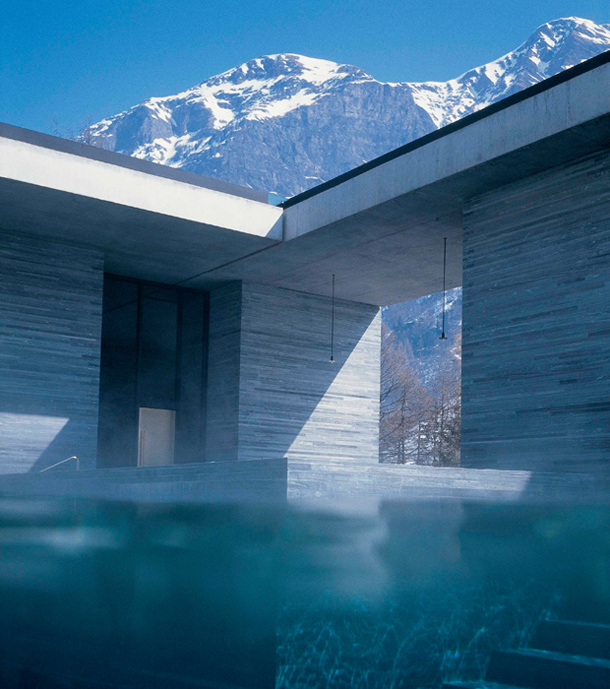
Pingback: Speculative Realism and architecture | Object-Oriented Philosophy
This is a very interesting article that analyses and celebrates the interfacing and integration of matter and data, of actual and virtual, that characterises what Lyotard called the “postmodern condition”. This new condition is based on the “epistemological erosion” of the mythological barriers of demarcation edified and imposed in the past, and that were not really undone by modernism, but merely reversed or transgressed. The new works of art are based rather on the fluid structures and transversal paths across membranes that do not function as binary barriers, on composition rather than opposition, on hybridisation and pluralist proliferation. The vision articulated in this article has much more to do with Bruno Latour’s philosophy of hybridisation as summarised in WE HAVE NEVER BEEN MODERN than with Graham Harman’s object-orinted ontology, which is based on a rigid separation between real object. and sensory object.
For details see: https://www.academia.edu/1572436/REVIEW_OF_GRAHAM_HARMANS_THE_THIRD_TABLE